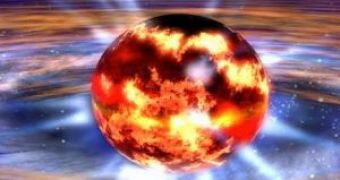A neutron star (a type of dense stellar object), named XTE J1739-285, seems to spin at an amazing intensity of 1122 rotations per second, 1.5 times more rapidly than the next neutron star, at 716 rotations per second.
The discovery enhances the idea of the existence of exotic "soft" states of matter inside dense stars.
Researchers had believed that neutron stars emitted gravitational waves that limited their spin rates to the maximum previously observed speed, but the new observation challenges this.
If the new finding is confirmed, the neutron star must be much denser, containing an unknown type of matter to hold on without being ripped apart by its ultra-fast spin movement.
The research team at the University of Iowa in Iowa City, US was employing NASA's Rossi X-ray Timing Explorer (RXTE) satellite to observe violent outbursts on a neutron star fiddling matter from a nearby companion star. When the stolen matter reached a threshold, it triggered a thermonuclear blast that forms X-rays and in such a blast, the researchers discovered regular brightness variation frequency of 1122 Hz, linked to the star's spin, which alternates bright and dark sides. "If correct, having a neutron star spin this fast removes any real need for something like a gravitational wave limit on neutron star spin rates," said Philip Kaaret, lead researcher.
"There is still a small chance that the apparent high frequency signal was just due to random fluctuations rather than the star's spin rate. It's really important that the signal be confirmed," he added. "The signal itself looks real." said neutron star expert Jean Swank of NASA's Goddard Space Flight Center in Greenbelt, Maryland, US.
But there is also the variant that matter settling on the star again after being initially spitted away by the explosion could provoke this effect. "It seems to me that that possibility has not been ruled out," she said.
Softer matter would be crushed under gravity to form a more compact object and the scientists still do not know how the matter behaves in the ultra-dense interiors of neutron stars, where a limited amount of matter presents a mass of 100 million tonnes.
Any information would be a breakthrough in this field. "If the object is as compact as the observation suggests, it might even be made of something called strange matter," said Fridolin Weber of San Diego State University in California, US.
This is a hypothetical matter constituted of free-roaming elementary particles named quarks. Quarks are never found alone in ordinary matter, they are bound in more massive particles, like protons.
Image credit: NASA

 14 DAY TRIAL //
14 DAY TRIAL //